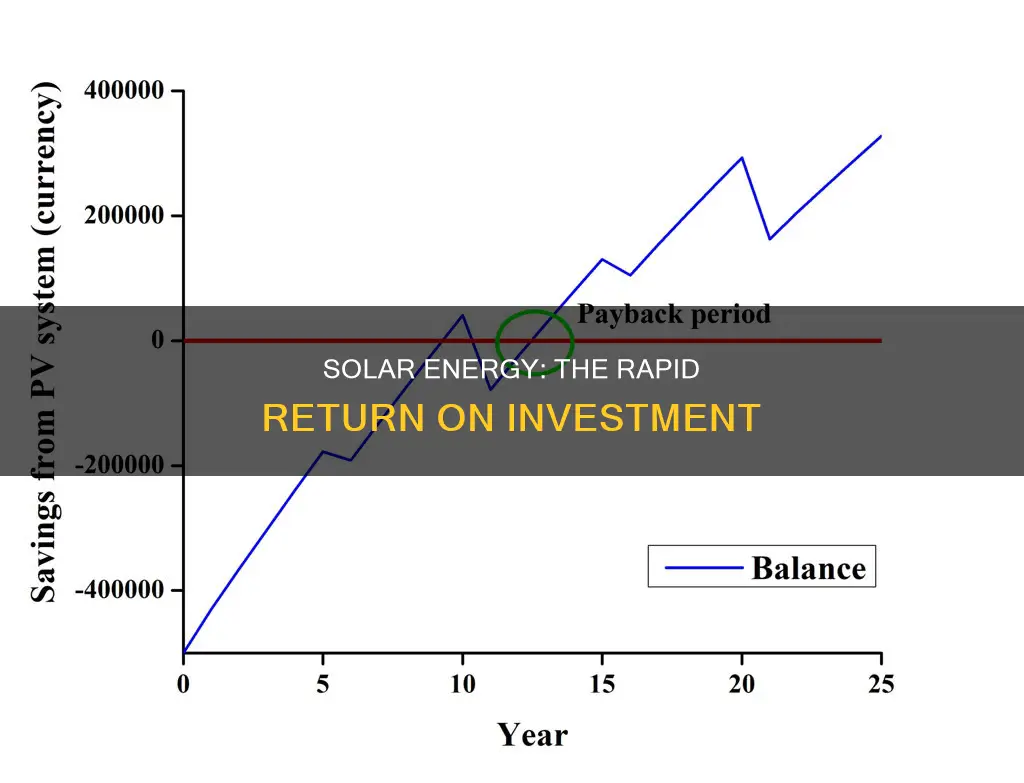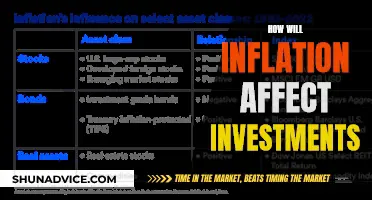
Solar panels are an expensive investment, with the average cost of solar panel installation in the US being $17,000. However, solar panels can save you a lot of money on electricity bills and might even make you money if you can sell energy back to the grid. The time it takes for solar panels to pay back their cost depends on several factors, including the size of the initial investment, the price of electricity, available incentives, and how much sun the panels get.
On average, solar panels in the US pay back their cost between 5 and 15 years. However, this can vary depending on the state and individual circumstances, with some sources giving a range of 7 to 20 years.
What You'll Learn

Solar payback period: 7-20 years
Solar panels can be an expensive investment, with the average cost of solar panel installation in the US being $17,000, although this can be as low as $5,000 in some states. The payback period for this investment varies depending on a number of factors, but it generally falls between 7 and 20 years.
The payback period is the time it takes for the money spent on solar panels to be outweighed by the money saved (or earned) on electricity bills. This period can be calculated by dividing the net cost of the solar system (after discounts and incentives) by the annual bill savings. The average payback period for EnergySage customers is under eight years. Most homeowners in the United States can expect a payback period of between 9 and 12 years, but this can be as short as five years in states like Hawaii and Massachusetts, and as long as 16 years or more in states like Louisiana and North Dakota.
The payback period depends on a number of factors, including the cost of the solar system, the availability of incentives and rebates, the amount of electricity generated by the system, and the cost of electricity from the utility company. Other factors include the size of the initial investment, the electric rate from the utility company, and how much sun the panels get.
Once the payback period is up, the real savings start, as any energy generated beyond this point represents a profit on the investment. Solar panels are designed to last for 25 years, so there is potential for significant savings over their lifetime.
Smart Ways to Invest $10,000
You may want to see also

Incentives and tax credits
Federal Tax Credits
The US federal government offers a solar tax credit known as the residential clean energy tax credit or the federal solar Investment Tax Credit (ITC). This credit can help homeowners recoup up to 30% of the cost of installing a solar power system until 2032. The credit will then decrease to 26% in 2033 and 22% in 2034 before expiring in 2035 unless renewed by Congress. The credit is claimed by filling out IRS Form 5695.
The federal solar ITC is available to those who meet the following criteria:
- The solar system was installed between January 1, 2017, and December 31, 2034.
- The system is located at your residence in the US, which includes a house, mobile home, houseboat, condominium, cooperative apartment, and manufactured home.
- You own the solar system outright (bought with cash or financed) but are not leasing it or paying a solar company for the electricity generated.
- The solar system is new or being used for the first time.
The federal solar ITC covers the following expenses:
- Solar panels or PV cells
- Energy storage devices with a capacity of 3 kWh or more
- Contractor labour expenses, including site preparation, assembly, or installation
- Balance-of-system equipment, including wiring, inverters, and mounting equipment
- Sales taxes on eligible expenses
State and Local Incentives
In addition to federal incentives, many states and local governments offer their own incentives to encourage the adoption of solar energy. These can include:
- Property tax exemptions
- State tax credits
- State government rebates
- Local utility rebates
- SREC markets
Other Incentives
Other incentives that can help reduce the cost of solar energy systems include:
- Net metering: This allows you to sell excess solar energy generated back to the grid in exchange for power bill credits. However, the export tariffs received are usually much lower than the electricity prices paid.
- Renewable energy certificates: These are earned by generating renewable energy and can be sold to utility companies or other buyers. However, the payments received may be considered taxable income.
Chipotle: A Smart Investment for Your Portfolio
You may want to see also

Energy consumption
The time it takes for solar panels to pay back their initial investment depends on several factors, with energy consumption being a key variable. The payback period is shorter in markets with expensive utility rates, as solar energy offsets the cost of electricity drawn from the grid.
The amount of energy that solar panels can generate depends on the size of the installation, the amount of direct sunshine, and the quality of the installation. Maximising the available space for solar panels, such as on rooftops, empty land, or parking lots, can increase energy production and improve the payback period.
For example, the average American household with an energy usage of 914 kWh per month and a rate of 12.95 cents per kWh would take 9.44 years to break even on a solar installation if they hired a contractor. However, if they chose to install the system themselves, the payback period would be reduced to 6.11 years.
Additionally, higher electricity costs can shorten the payback period. In states with high electricity rates, such as Rhode Island, the payback period can be as short as 3.64 years for a DIY installation or 5.63 years with a contractor.
On the other hand, lower electricity rates can lengthen the payback period. In Louisiana, which has the lowest electricity rates in the contiguous 48 states, the payback period for a contractor-installed system is estimated at 13.45 years.
Overall, the payback period for solar panels is influenced by energy consumption and costs, with higher energy usage and rates leading to shorter payback periods and lower rates resulting in longer periods.
Millions Have $1M to Invest
You may want to see also

Electricity production
The payback period for solar panels is the time it takes for you to break even and start saving money after paying for your solar system. The average payback time for a home solar installation in the United States is about 10 years, but this can range from 5 to 15 years depending on where you live.
The payback period for solar panels is influenced by several factors, including the cost of solar panels, financing, installer rates, credits and rebate incentives, electricity consumption and rates.
The total cost of your solar system includes the cost of the solar panels themselves, as well as installation and any additional accessories and fees. The more you pay for your system, the longer it will take to recoup your costs. Solar systems can range in price from a few thousand dollars to tens of thousands, depending on where you live, your electricity needs and the type of system you choose to install.
Solar incentives and tax breaks can also help reduce the cost of solar panels. Homeowners can take advantage of federal, state and local incentives and rebates when they pay for their system out-of-pocket or with a solar loan. In 2023, the federal tax incentive was 26%, a significant chunk of the total system price, accelerating the payback period. State and local-level incentives include state exemptions and property taxes. Net metering programs offer the opportunity to sell your unused energy back to the grid in the form of Solar Renewable Energy Certificates (SRECs).
The amount of electricity your household uses monthly, as well as the cost of electricity in your area, will also influence your solar payback period. The higher your electric bill, the greater the savings and the faster you'll reach your payback period.
To calculate your solar payback period, you can use the following formula: (Total System Cost – Value of Incentives) ÷ Cost of Electricity ÷ Annual Electricity Usage = Payback Period.
For example, let's say your total system cost is $20,000 and you qualify for incentives and rebates totalling $7,200. Your total cost after incentives would be $12,800. If your annual electricity bill is $1,500 and your solar system is expected to cover 80% of your electricity needs, your yearly savings would be $1,200. To calculate your payback period, you would divide the net cost of your system ($12,800) by your yearly savings ($1,200), giving you a payback period of 10.67 years.
Solar panels can be an excellent investment, but it's important to consider all the factors that can impact your payback period to make an informed decision.
Networking: Your Secret Weapon for Success
You may want to see also

Cost of electricity
The cost of electricity is a key factor in determining the payback period for solar panels. The payback period is the time it takes for the savings on energy bills to recoup the initial cost of installing solar panels. The higher your electricity bill, the shorter the payback period, and the quicker you will start making savings.
The cost of electricity varies across the US, with an average monthly bill of $118.36 for an American household. The cost of electricity depends on the local regulatory environment and can be divided into three categories: wholesale costs, retail costs, and external costs. Wholesale costs include initial capital, operations and maintenance, transmission, and decommissioning costs. Retail costs are what the consumer pays, and external costs are the societal costs imposed by the generation of electricity, such as environmental impacts.
The levelized cost of electricity (LCOE) is a metric used to compare the costs of different electricity generation methods. It is calculated by taking the net present value of all costs over the lifetime of the project and dividing it by the total energy output over that lifetime. The LCOE of solar power can be as low as $0.03 per kilowatt-hour for utility-scale installations, making it competitive with conventional energy sources.
The time it takes for solar panels to pay back their cost depends on various factors, including the price of electricity, the amount of sunlight received, the size and type of the solar system, and available incentives. In the US, the payback period typically ranges from 5 to 15 years, with an average of about 10 years.
Solar panels can be a worthwhile investment, especially in areas with high electricity rates. They not only reduce electricity costs but also increase energy independence and the value of your home.
Investments: Where People Put Their Money Now
You may want to see also
Frequently asked questions
The payback time for solar panels depends on several factors, including the size of the initial investment, the cost of electricity, and the availability of sunlight. On average, solar panels pay for themselves in about 7 to 10 years in the United States.
The payback period for solar panels can be influenced by various factors, including the total cost of the solar system, incentives and tax credits, energy consumption, electricity production, and the cost of electricity.
To calculate the payback period for your solar panels, you can use the following formula: (Total solar system costs - rebates) / Electricity bill savings per year = Payback period in years. This will give you the number of years it takes for your solar panels to pay for themselves.
Yes, there are incentives and tax credits available for solar panels that can help reduce the cost. For example, the federal residential clean energy credit in the United States offers a tax credit of up to 30% for solar system installations.







